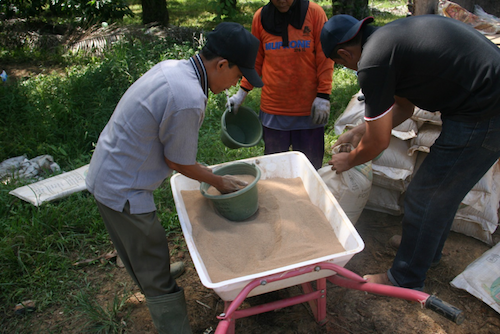Budidaya Kelapa Sawit Berkelanjutan / Mengaplikasikan fosfat (P)
Download: Module 4: Fertiliser Application
Contents
Goal
- Provide oil palms with sufficient phosphorus to produce optimum yields;
- Limit the loss of phosphorus to the environment.
Standard
Phosphorus fertiliser is applied according to the 4R principle: right type, right amount, right place, right time.
Timing
- When the soil is moist;
- Not during very strong rains or in the middle of the rainy season.
Frequency
1 or 2 doses per year (once per 6—12 months).
Labour time required
2—4 hours per hectare.
Equipment and materials
- Bucket, bag or wheelbarrow
- Kitchen scales
- Black marker
- Bowl of 1.5—2 L
- Fertiliser
Dosage
See: Table 4; Table 5; Table 6; Table 7.
Who
Farmers and their families or hired labourers.
How
Apply phosphorus fertiliser by following these steps:
| Step 1. | Before application, make sure that erosion control (i.e. terraces, dams) has been installed on sloping terrain because P fertiliser remains at the top of the soil for a long time and is therefore sensitive to loss by erosion or runoff. |
| Step 2. | Make sure the plantation is well maintained, noxious weeds have been removed and ground cover has been slashed to 50 cm height. |
| Step 3. | Weigh the amount of fertiliser to be applied in a bowl or cup, using kitchen scales. |
| Step 4. | Mark the bowl/cup at the right amount using a black marker pen. |
| Step 5. | Apply the fertiliser in the following way:
If palms are on the edge of a river, road or ditch, avoid applying fertilisers on the side of the palm closest to the edge. |
Note: For very acidic soils (pH < 4.0) and peat soils it is better to use rock phosphate than TSP (see Figure 20).
Data recording
Every fertiliser application should be recorded in a logbook as shown in the example below.
| Date | Time | Location | Activity | Input type | Input amount | Input costs | Labour input | Labour costs | |
| People | Hours | ||||||||
| 16/01/13 | Field 3 | Fertiliser: P | TSP | 300kg | 300000 | 1 | 4 | 40000 | |
Acknowledgements
The material from Applying phosphate (P) is sourced from Smallholder Oil Palm Handbook and put together by Lotte Suzanne Woittiez (Wageningen Universit) and Haryono Sadikin, Sri Turhina, Hidayat Dani, Tri Purba Dukan, and Hans Smit (SNV) in August 2016. See Module 4: Fertiliser Application for more information.




